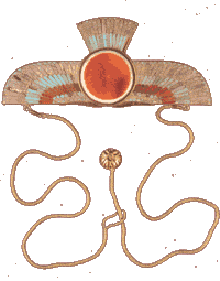
|
GOLD,
CARNELIAN ,TURQUASE AND METAMORPHIC STONE
Height 6.3 cm. ; width 14.6 cm. ; weight 151.20 gr.
USAK MUSEUM
The pectoral is in the form of a winged solar disk. The gold setting
contains a disk of layered carnelian agate, cut so that a white
layer between two layers of red creates a narrow inner border. Wings
and tail have cloisonne filled with carnelian, turquoise and a brown
metamorphic stone. Below a curved gold shoulder border are three
rows of short feathers, turquoise flanking brown stone, above three
rows of elongated feathers. The upper row of long feathers are carnelian,
the centre row turquoise, and the bottom row cut from the brown
stone. The feathers of the two upper rows have rounded ends, those
of the lower row have pointed ends. The triangular interstices around
the lower edge are filled mostly with turquoise, and some brown
stone. The tail has two rows of elongated feathers, the upper row
turquoise, the lower of brown stone; again the interstices are filled
mostly with turquoise, and some brown stone. The back of the pectoral
is plain gold. Near the upper tip of each wing is soldered a small
ring, serving for the attachment of a length of multiple loop-in-Ioop
chain. At the attachment end the chains terminate in plain cylindrical
collars with open wire rings which are hooked through the rings
on the pectoral. At the other end, one chain is looped, the other
terminates in a toggle. The toggle has cloisonne forming a rosette
of two rows of eight pointed petals which radiate from a circular
centre. The filling of the petals is mostly missing; one outer petal
still contains turquoise, one interstal space contains carnelian.
The winged solar disk is a common Achaemenid motif,
borrowed ultimately from Egypt. It appears, for example, on obviously
Persian-influenced gold applique plaques from Sardis. Another close
comparison is a winged sun-disk on a glazed brick wall from Susa,
where the same colours are used for the feathers, and the sun-disk
also has an outer white border. The motif also appears on a silver
phi ale from Ikiztepe . Agate cut in circles and ovals with narrow
inner white borders is also common in Achaemenid jewellery; for
example, the bracelet no. 129, beads of a necklace from Çayiralan
near Yozgat (Ankara Museum of Anatolian Civilizations AMM 15128),
and beads from Susa and Pasargadae. The technique is attested from
royal graves of the 8th century BC at Nimrod in Assyria.
|
|









